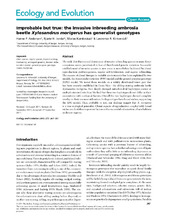Improbable but true: the invasive inbreeding ambrosia beetle Xylosandrus morigerus has generalist genotypes
Peer reviewed, Journal article
Published version

Åpne
Permanent lenke
http://hdl.handle.net/1956/12364Utgivelsesdato
2012-01Metadata
Vis full innførselSamlinger
Originalversjon
https://doi.org/10.1002/ece3.58Sammendrag
The wide distribution and dominance of invasive inbreeding species in many forest ecosystems seems paradoxical in face of their limited genetic variation. Successful establishment of invasive species in new areas is nevertheless facilitated by clonal reproduction: parthenogenesis, regular self-fertilization, and regular inbreeding. The success of clonal lineages in variable environments has been explained by two models, the frozen niche variation (FNV) model and the general-purpose genotype (GPG) model. We tested these models on a widely distributed forest pest that has been recently established in Costa Rica—the sibling-mating ambrosia beetle Xylosandrus morigerus. Two deeply diverged mitochondrial haplotypes coexist at multiple sites in Costa Rica. We find that these two haplotypes do not differ in their associations with ecological factors. Overall the two haplotypes showed complete overlap in their resource utilization; both genotypes have broad niches, supporting the GPG model. Thus, probable or not, our findings suggest that X. morigerus is a true ecological generalist. Clonal aspects of reproduction coupled with broad niches are doubtless important factors in the successful colonization of new habitats in distant regions.
